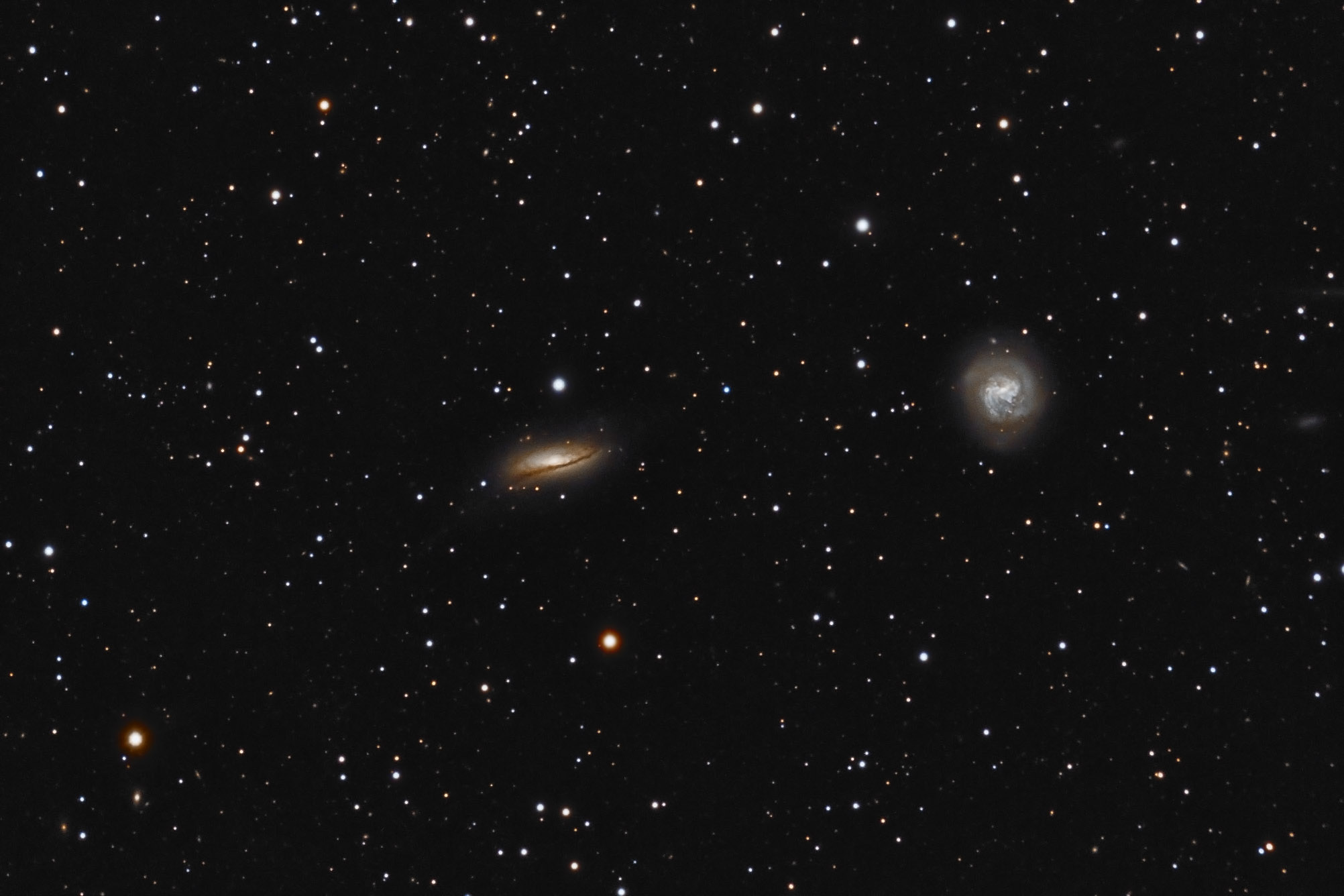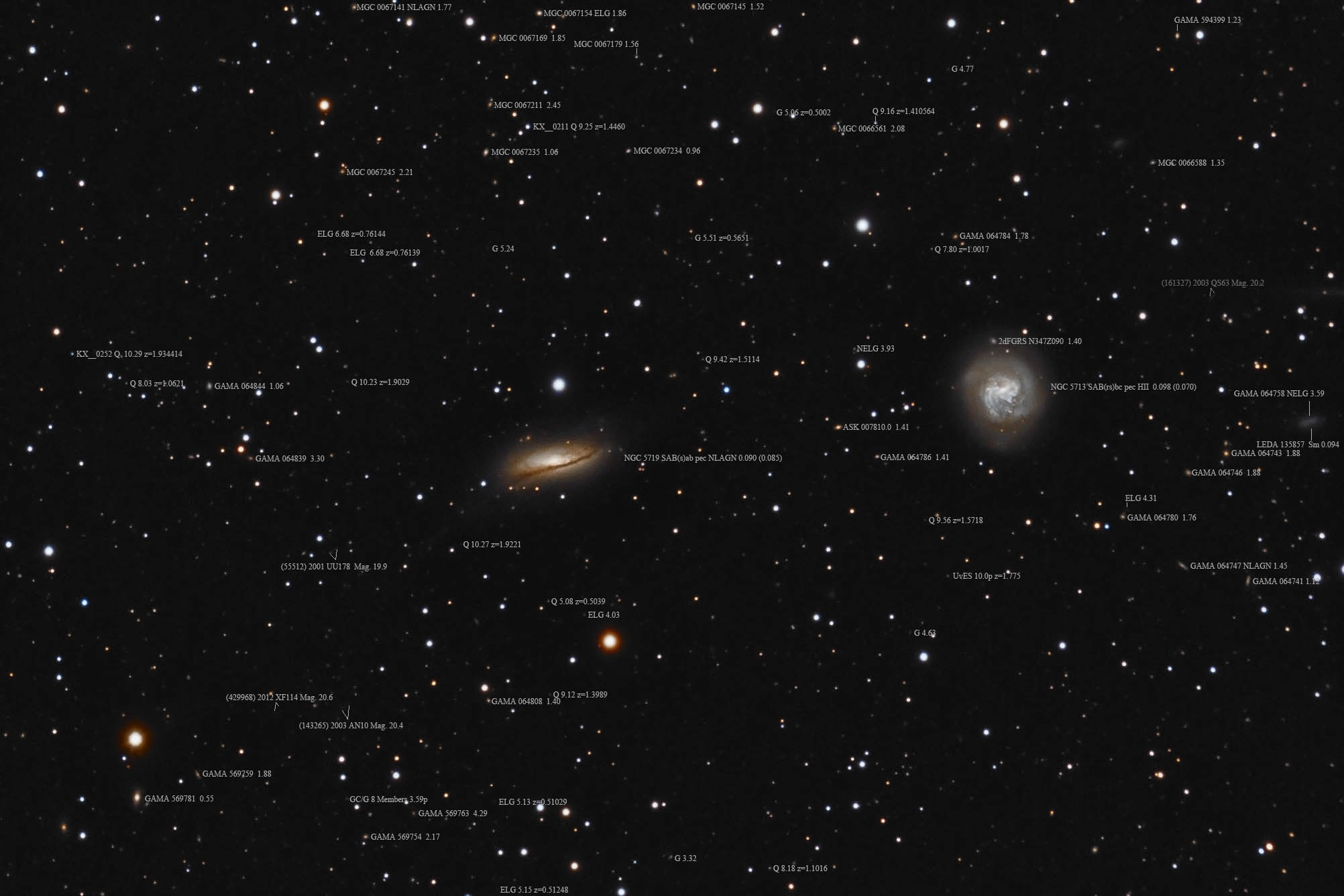Object name: NGC5719Designation(s): NGC5719, NGC5713, NGC 5713 and NGC 5719 are a pair of possible interacting galaxies. Most consider them an interacting pair. The pair are located in eastern Virgo at a distance of maybe about 80 million light-years. I found large disagreements here as shown on the annotated image. I'm rather arbitrarily picking the 80 million light-year distance.
NGC 5713 is a highly disturbed SAB(rs)bc pec spiral. It would have fit Arp's one spiral arm category. Including plumes, it is some 70,000 light-years in diameter. It was discovered by William Herschel on April 11, 1787. It isn't in either of the Herschel observing programs.
NGC 5719 is a rather edge on SAB(s)ab pec spiral containing a narrow line AGN at its core indicating its black hole is actively feeding. The slanted heavy dust lane is said by some to indicate the disk is warped. The fainter dust lanes, however, appear rather normal without any slant. One paper that has studied this galaxy finds that about 20% of its stars are orbiting in retrograde compared to the other 80%. The paper says this is likely due to acquiring mostly molecular hydrogen likely torn from both galaxies by their interaction which then has turned into stars. I assume the slanted dust lane has a similar origin? http://adsabs.harvard.edu/abs/2007A%26A...463..883V This galaxy was also discovered by William Herschel on April 11, 1787 the same time he found 5713. It is some 90,000 light-years across including its faint outer regions. It too isn't in either of the Herschel observing programs.
There's a third galaxy that apparently is related to these two on the right edge of my frame which I've labeled as LEDA 135857 (PGC 135857 in some catalogs). Oddly NED also shows it as GAMA 064758. But instead of it being about the same redshift as the NGC galaxies that entry says it is some 3.59 billion light-years distant and calls it a Narrow Emission Line Galaxy which isn't noted for the LEDA entry. If correct it would be some 700,000 light-years across. I think it safe to discard this identification as being a discovery by that all too often cited oriental astronomer Sum Ting Wong. Still, I noted it on the annotated image as well as the likely correct LEDA entry. The same paper mentioned above says it at the end of a large molecular hydrogen cloud created by the interaction of these two galaxies and its stars likely formed from it. If so it is a brand new galaxy some 25,000 to 30,000 light-years across.
Assuming the two NGC galaxies are at the same distance their projected separation is only about 266,000 light-years. Certainly, close enough they are still feeling each other's gravity well. Are they destined to eventually merge? I didn't find anything either way on this.
The annotated image contains 12 quasars plus one quasar candidate (UvES). Arp seemed to think quasars were associated with active or peculiar galaxies. I wonder if he knew of this field? NED listed over 200 objects in the field with redshift information. Many were ELG (Emission Line Galaxies) that were very faint. I point out the brighter ones and a couple of the very faint ones but after that ignored them as it would have filled the image with their catalog entries. It didn't help that this was taken on the same night as my last post so a lot of clouds passing by greatly reduced the depth of this image. My limiting magnitude is over one magnitude less than normal and nearly 2 less than on a really great night. Seeing, however, was reasonable so I didn't put it on the re-do list.
14" LX200R @ f/10, L=4x10' RGB=2x10', STL-11000XM, Paramount ME Related Designation(s):2dFGRS N348Z175, 2MASS J14401144-0017200, 2MASS J14405636-0019057, 2MASX J14401152-0017211, 2MASX J14405639-0019054, 2MASXi J1440114-001720, 2MASXi J1440563-001905, 87GB[BWE91] 1437-0004, AKARI J1440113-001726, AKARI J1440563-001904, APMUKS(BJ) B143822.95-000614.4, APMUKS(BJ) B143824.86-000619.7, ASK 007779.0, CGCG 019-077, CGCG 019-079, CGCG 1437.6-0005, CGCG 1438.4-0007, CGS 501, GALEXASC J144056.35-001905.4 , GAMA 064771, GAMA 064804, GAMA J144011.50-001720.3, GAMA J144056.33-001904.7, GAMA J144056.36-001905.5, GSC 4985 00315, GSC 4985 00384, H-ATLAS J144011.1-001725, H-ATLAS J144056.2-001906, HAPLESS 20, HAPLESS 29, HDCE 0886 NED002, HDCE 0886 NED003, HIPASS J1439-00A, HIPASS J1440-00, HIR J1440-0026, IRAS 14376-0004, IRAS 14383-0006, IRAS F14376-0004, IRAS F14383-0006, LDCE 1076 NED021, LDCE 1076 NED022, LGG 386:[G93] 009, LGG 386:[G93] 010, MCG +00-37-022, MCG +00-37-024, NGC 5713, NGC 5719, NGC5713, NGC5719, NSA 002493, NSA 165392, NVSS J144056-001906, PGC 052412, PGC 052455, PLCKERC545 G351.01+52.12, PLCKERC857 G351.01+52.11, PMN J1440-0017, SDSS J144010.75-001738.3, SDSS J144011.50-001720.3, SDSS J144056.35-001905.4, SDSS J144056.35-001905.5, SDSS J144056.36-001905.4, SDSS J144056.36-001905.5, SDSS J144056.36-001905.6, SSTSL2 J144056.31-001905.9, SwiftFT J144011.3-0017.4, UGC 09451, UGC 09462, USGC U648 NED03, USGC U648 NED04, UZC J144011.4-001727, UZC J144056.4-001905, VIII Zw 447, VLSS J1440.1-0017, [FNO2007] 1880, [FNO2007] 1885, [ISI96] 1438-0006, [LG2007] 65, [RHM2006] SFGs 084, [RHM2006] SFGs 129, [WB92] 1437-0004, [ZSK75] 1437.6-0005, | | 
